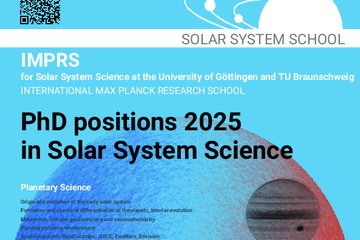All genres
121.
Conference Paper
Mean-field view on magnetoconvection and dynamo models. In: Proceedings of the Joint 15th Riga and 6th pamir International Conference, pp. 85 - 88. (2005)
122.
Talk
Expected retrieval accuracy of the Love number h2 from the BepiColombo Laser Altimeter (BELA). 19th BepiColombo Science Working Team Meeting , Noordwijk, Netherlands (2019)
123.
Talk
Expected insights on Mercury’s interior from the BepiColombo Laser Altimeter. European Planetary Science Congress, Geneva, Switzerland (2019)
124.
Talk
Combined retrieval of the lunar body tide and a global topographic grid from LOLA data. European Planetary Science Congress, Berlin, Germany (2018)
125.
Talk
Simultaneous retrieval of the h2 tidal Love number and the global shape of the Moon from laser altimetry. Asia Oceania Geosciences Society (AOGS) 15th Annual Meeting , Honolulu, Hawaii (2018)
126.
Talk
Algorithm for the retrieval of h2 from laser altimetry. BepiColombo SWT meeting, Braunschweig, Germany (2018)
127.
Talk
Rossby waves on the Sun. 15th European Solar Physics Meeting, Budapest, Hungary (2017)
128.
Talk
Improved algorithms for the retrieval of the h2 Love number of Mercury from laser altimetry data. European Geosciences Union General Assembly, Vienna, Austria (2017)
129.
Talk
Planetary magnetic fields. International School of Space Sciences (ISSS), L'Aquila, Italy (2016)
130.
Talk
Realistic force balance in geodynamo simulations. 17 th MHD Days , Göttingen, Germany (2016)
131.
Talk
Realistic force balance in geodynamo simulations. AGU, San Francisco, USA (2016)
132.
Talk
DFG Leibnitz Lecture: Magnetic Fields-a Window into the Interior of Planets. Goethe-Institut , San Francisco, USA (2016)
133.
Talk
Dynamos the planetary-stellar connection. The dynamo effect in astrophysical and laboratory plasmas, Princeton, USA (2015)
134.
Talk
Saturns magnetic field and dynamo. AOGS Meeting, Singapore (2015)
135.
Talk
Planetary dynamos with stably stratified layers. GDR Dynamo Discussion Meeting, Bangalore, India (2015)
136.
Talk
Des Kometen Kern: Erste Ergebnisse der Rosetta-Mission. Reihe Faszinierendes Weltall, Göttingen, Germany (2015)
137.
Talk
Rosetta unveiling of a comet. XLAB Science Camp, Göttingen, Germany (2015)
138.
Talk
Das Innere der Planeten und ihre Magnetfelder. Volkshochschule Hildesheim, Hildesheim, Germany (2015)
139.
Talk
Surface compositional heterogeneity of (4) Vesta from Dawn FC using a 3 dimensional spectral approach. European Planetary Science Congress, Nantes, France (2015)
140.
Talk
An iron snow dynamo in Ganymede's core. Conference on the Dynamics of Planetary and Stellar Interiors, San Diego, USA (2014)











